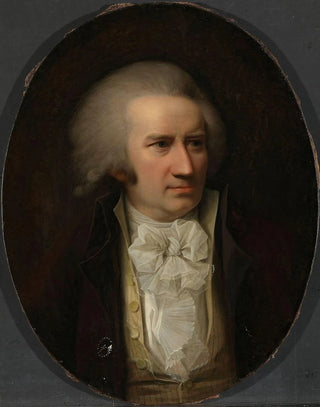Art print | Portrait of Bernt Anker Chamberlain Bernt Anker - Jens Juel


View from behind

Frame (optional)
In the fascinating world of Danish painting, the "Art print of Bernt Anker Chambellan Bernt Anker" by Jens Juel stands out as an iconic work of the 18th century. This portrait does not merely capture the physical appearance of its subject; it also evokes psychological depth and historical richness that immerse the viewer in the era in which it was created. Through the features of Bernt Anker, an influential man in Danish society, Juel manages to transcend the simple exercise of representation to offer a reflection on power, status, and identity.
Style and uniqueness of the work
Jens Juel's style is characterized by striking realism and meticulous attention to detail. In this piece, Juel uses a palette of rich colors and subtle play of light to bring his subject to life. The delicately placed shadows and luminous reflections on the fabrics demonstrate impressive technical mastery. Bernt Anker's face, marked by an expression that is both serious and contemplative, invites deep reflection. Symbolic elements, such as carefully chosen accessories and the posture of the figure, add a narrative dimension to the work, suggesting a personal story and a prominent social role. This portrait, with its harmonious composition and expressiveness, proves to be a true masterpiece that captures the very essence of its time.
The artist and his influence
Jens Juel, born in 1745, is often regarded as one of the most important portraitists in Denmark. Trained abroad, notably in France, he was able to incorporate European influences while maintaining a sensitivity unique to his homeland. Juel had the opportunity to paint many eminent figures of his time, and his work greatly contributed to shaping the genre of portraiture in Scandinavia. His ability to render the psychological traits of his subjects, through nuanced expressions and eloquent postures, marked an evolution in the way portraits are conceived. By immortalizing Bernt Anker, Juel does not merely depict a man but also bears witness to the importance of Danish nobility.

Matte finish

View from behind

Frame (optional)
In the fascinating world of Danish painting, the "Art print of Bernt Anker Chambellan Bernt Anker" by Jens Juel stands out as an iconic work of the 18th century. This portrait does not merely capture the physical appearance of its subject; it also evokes psychological depth and historical richness that immerse the viewer in the era in which it was created. Through the features of Bernt Anker, an influential man in Danish society, Juel manages to transcend the simple exercise of representation to offer a reflection on power, status, and identity.
Style and uniqueness of the work
Jens Juel's style is characterized by striking realism and meticulous attention to detail. In this piece, Juel uses a palette of rich colors and subtle play of light to bring his subject to life. The delicately placed shadows and luminous reflections on the fabrics demonstrate impressive technical mastery. Bernt Anker's face, marked by an expression that is both serious and contemplative, invites deep reflection. Symbolic elements, such as carefully chosen accessories and the posture of the figure, add a narrative dimension to the work, suggesting a personal story and a prominent social role. This portrait, with its harmonious composition and expressiveness, proves to be a true masterpiece that captures the very essence of its time.
The artist and his influence
Jens Juel, born in 1745, is often regarded as one of the most important portraitists in Denmark. Trained abroad, notably in France, he was able to incorporate European influences while maintaining a sensitivity unique to his homeland. Juel had the opportunity to paint many eminent figures of his time, and his work greatly contributed to shaping the genre of portraiture in Scandinavia. His ability to render the psychological traits of his subjects, through nuanced expressions and eloquent postures, marked an evolution in the way portraits are conceived. By immortalizing Bernt Anker, Juel does not merely depict a man but also bears witness to the importance of Danish nobility.






